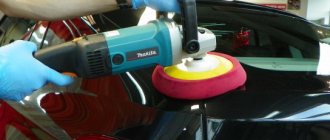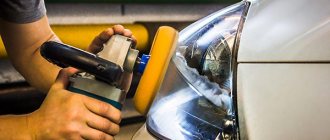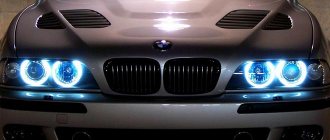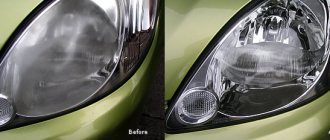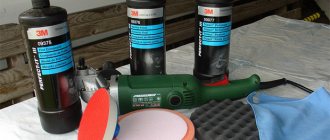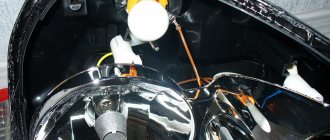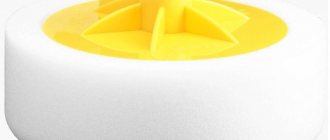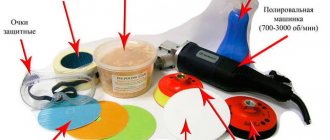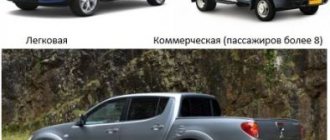Let's turn to GOST
You probably know that there are rules and laws regarding tinting car windows. Just recently I talked about removable tinting, and we also discussed the issue of curtains for a car. I advise you to refresh your memory and read the materials again. In addition to them, I would suggest that you familiarize yourself with removable tinting on a rigid base, the link to which will be, and removable silicone tinting with a link.
Category: Tuning
Now let's talk specifically about the rear lights. There are no requirements for their tinting. There are only regulations for the operation of automotive lighting equipment. Regarding the rear optics, it states that only yellow, red and orange light can be used. All others are prohibited.
There is one correction here. To illuminate the reversing lamp in the Russian Federation, only white light is used, as well as to illuminate the license plate.
These are the only official rules regarding this matter. That’s why you need to rely on them when you decide to tint the rear optics. If any color other than those listed is used, when recording this fact, law enforcement officers will classify this as an offense. Therefore, you will be issued a fine.
Potential penalties
If there is tinting on the rear optics that does not correspond to the characteristics prescribed in the Code of Administrative Offenses, then the driver of the vehicle will be fined.
Only here there are important nuances. The thing is that in the current legislation there are no specific clauses that relate specifically to rear optics. Just don’t think that it’s now legal to tint your headlights any color you like.
Here, traffic police officers will rely on Article 12.5 Part 1 of the Administrative Code. That is, they will charge you with a violation due to vehicle malfunctions in accordance with the requirements for permitting a vehicle to operate. If your taillights are in poor condition, get ready to receive a fine of 500 rubles.
Drivers note that traffic police officers rarely issue fines for such violations. And if you tint the optics without changing the color of the instruments, then there will be no problems at all.
Even though there is practically no threat of a fine in this situation, it is still necessary to remind you about the methods of paying fines. There will be a link to interesting and useful material about this.
Manufacturers
The Delta Kits company produces single varnishing kits. The set includes:
- two-component varnish;
- degreaser:
- polishing paper in calibration 320,500,800,1200,1500,3000 grit.
- felt lint-free napkin.
With one set you can polish your optics yourself and apply Delta Kits varnish. Its main advantage is the protection of plastic from UV, maintaining the transparency of the restored headlight for up to 22 months.
The manufacturer Dovlight produces kits for restoring car optics, two-part and aerosol varnishes, headlight cleaners, and anti-rain. Polyurethane varnishes are characterized by a small percentage of solids, dry quickly, hardening occurs in 20 minutes, complete drying in 24 hours. Restores initial light penetration by 98%. Well-known manufacturers:
- Diamond Vision;
- Meguir's;
- Philips Headlight;
- Presto.
The degree of wear of the block affects the choice of reducing agent. Depending on the number of scratches and chips, the restoration option will depend: napkins without sanding, light sanding, polishing or serious restoration.
When carrying out the headlight grinding procedure, the question arises of what varnish to coat the headlights with in order to achieve the best effect. The choice should be based on the good reputation of the manufacturer, reviews of a specific product and the type of glazing material. A good headlight varnish should provide protection, eliminate scratches of varying depths, and restore a clear, original appearance.
Polyurethane varnish
One of the most common types of protective chemicals for automotive optics. It consists of a solvent and a varnish base mixed in different proportions.
It is necessary to restore the optics and remove yellowness only after polishing the headlight, washing and drying it. The quality of the brightness of the optics and the durability of the coating depend on the adhesion strength of the surface and the varnish composition.
Polyurethane varnishes are equally suitable for restoring plastic and glass cases. If the interior of the polycarbonate headlight peels off and the optics become cloudy, replacement is recommended. It will no longer be possible to restore the quality of light output.
Causes of cloudiness
Yellow headlights, if this is not a special type of tuning, cause sympathetic glances from drivers and problems with traffic police inspectors. The requirements for the quality of road lighting are high, and if the lights have dimmed significantly, this is a direct violation of traffic regulations.
The cases are made of glass and plastic. Optics manufacturers refuse to use glass for many reasons:
- expensive;
- glass blocks are heavy;
- do not require frequent replacement and are not profitable to produce.
It takes more than one year for headlights made of glass to become cloudy. Plastic cases are 70% lighter and 560% softer than glass. It is beneficial for manufacturers to use plastic, because car owners have to spend more time and money on maintaining them. Reasons why optics units turned yellow or cloudy:
- Systematic impact of gravel, which hits the lights at speed.
- Using light bulbs of unspecified power: the protective coating in the plastic peels off from the inside.
- Dust accumulates in microscopic cracks.
- Overheating during polishing causes the plastic to become cloudy and dark.
If the lights have lost their transparency, you can restore the optics with varnish, after polishing the surface.
Ceramic varnish
Car enthusiasts who believe that the chemical composition of polycarbonate ceramic varnish contains elements of ceramics are mistaken. The material received its name due to the great similarity of the hardened varnish to natural ceramics. More often used for painting the body, it has up to hundreds of shades from matte to chameleon.
Ceramic varnish to restore the transparency of headlights is more often used in garage repairs. A transparent composition is selected that gives shine and gloss to the glass surface. Apply with a brush or spray.
Ceramic varnish “heals” microcracks and completely restores the surface due to its non-uniform hardness. The outer microlayer has increased hardness, the inner one is elastic. When a scratch occurs, the inner layer fills the crack, restoring the original appearance.
Recommendations from experts
When polishing with your own hands, you should follow the recommendations of experienced craftsmen:
- Before starting the procedure, inspect the surface and remove any remaining sealant.
- Dry the glass surfaces thoroughly so that drops of moisture do not boil when working with a hairdryer, otherwise this may lead to the formation of cracks.
- After varnishing, the parts should dry for 24 hours.
- To speed up the hardening of the protective layer, you can use a hairdryer. In this case, the air stream should be directed at the headlight for no longer than 10 minutes; the air temperature should not be high.
- When using a 2-component varnish, it is advisable to dilute it in small quantities - each portion should be used up within 10 minutes.
- To restore the transparency of the headlights, a ceramic composition is also used.
- Perform work in personal protective equipment: gloves, respirator, special glasses.
It is also recommended to use anti-gravel film as a finishing layer - it will enhance the strength properties of the varnish.
Headlight restoration (polishing and varnishing)
The recovery process includes two stages:
- Car headlights are being polished.
- A special varnish is applied to the optics.
The first step is to thoroughly wash the headlights with detergent. Next, you need to evaluate the existing damage; if there are no large chips or cracks, but only small scratches, then there is no need to dismantle the optics. It will be enough to protect the bumper and hood with cellophane film, and apply masking tape to the surface around the optics. If the inner surface begins to peel off, you will need to remove the optics and restore the material on both sides. The restoration process will include the following steps:
- the part is dismantled, all the bulbs and gaskets are removed from it;
- it is heated with a hairdryer until the transparent part is easily separated from the second part of the part. You need to separate slowly, very carefully, you need to work with gloves so as not to get burned;
- the surface is thoroughly washed;
- grinding or polishing is performed. First, coarse-grained sandpaper is used to remove the protective layer and damage, after which the surface is sanded with fine-grained sandpaper;
- periodically it is necessary to remove particles of material and abrasive dust;
- the surface is sanded and matted, it is necessary to add moisture to achieve transparency and eliminate all damage;
- the material is dried and degreased;
- treatment is carried out using a napkin with an activator;
- a layer of varnish is applied from a can or from a container;
- The varnish solution should not be applied in a thick layer. The application process is carried out from a spray bottle or using a brush or lint-free cloth. It is necessary to apply one and a half to two layers;
- The varnished surface usually polymerizes for about one day; after this time, the part is glued together using heat and installed in its place.
Varnish for rear and headlights - treatment for polishing and tinting glass
Polishing the front and rear optics can be done in 2 ways:
- With dismantling of parts;
- No on-site dismantling.
The first method allows not only to apply a protective composition to the surface, but also to eliminate significant damage.
The varnish is used as a polishing coating - it is used to restore old lenses. The benefits of polishing include the following:
- eliminating scratches and chips;
- protection of the material from dirt and aging;
- prevention of minor mechanical damage;
- improvement of appearance.
In addition, the varnish reduces the negative impact of aggressive chemicals. For example, it protects against road surface salts used in winter to cause ice formation. The protective composition is applied only after final polishing of the surfaces.
What tools and materials are needed for varnishing
There are two ways to polish headlights and varnish them:
- without removing the headlights from the car. This method is suitable when there is minor damage;
- with the removal of the optics and its restoration.
Whatever method of polishing headlights and subsequent varnishing is used, the following materials and tools will be needed:
- any detergent;
- masking tape;
- rag;
- sandpaper of various grits, from 320 to 2500;
- an electric sander with a soft backing;
- several napkins;
- solvent or degreaser;
- varnish mixture;
- construction or regular hairdryer.
If scratches, chips appear on the optics, or if the material becomes cloudy, then the light will pass through poorly, as a result, the headlights will begin to heat up, and the polycarbonate layer will gradually deteriorate. To restore the material, you can purchase a special kit in the store, which includes all the necessary materials for restoration, but you can also assemble everything you need to polish the headlights under a layer of varnish yourself. The necessary tools are listed above.
Types of varnishes
Different types of modern varnishes applied to the polishing layer have different refractive indices, therefore, they transmit light through them differently. Varnishes can be divided into two categories, depending on what type of surface they are applied to:
- compositions for glass;
- varnish mixtures for polycarbonate and acrylic materials.
In addition, protective varnish for headlights can have different functional purposes:
- protective composition produced in the form of an aerosol or two-component liquid;
- tinting varnish solution.
Protective varnish can have different compositions; depending on this, varnish solutions are divided into the following categories:
- one-component, acrylic based. This varnish for polishing headlights can be of any shade or completely transparent; it is applied very easily and simply, with your own hands. It dries quite quickly, has a glossy shiny surface, but this solution does not fill chips and cracks very well and does not adhere very well to polycarbonate;
- A two-component varnish that protects the headlights after polishing. This material is sold in two different containers, one containing varnish and the other containing hardener. These two components must be mixed before use. Two-component varnish coating is the most durable and durable; professional specialists choose this particular type to protect headlights;
- urethane car varnish. It is completely transparent, comes in the form of an aerosol can, and must be applied to a previously cleaned surface. Many people choose to coat their headlights with this particular type of varnish, because the urethane solution provides reliable protection for the material from mechanical damage and weathering. The urethane mixture also enhances the luminous flux; during polishing and varnishing work, in order to cover the headlights with the composition, you do not need to remove them from the car.
Automotive varnishes used for headlight polishing can be classified according to the volume of dry residue and hardness index. Each composition has its own concentration of polymer substances, depending on this, varnish mixtures have different markings:
- HS means that the varnish has a high percentage of solids and the smallest volume of solvent. This composition has a rich shine; it needs to be applied in one and a half layers;
- MS has an average solvent and solids content. This variety is applied in two or three layers; you must wait until each layer dries;
- UHS is a solution containing the maximum volume of polymer substances. This variety is highly resistant to damage and dries very quickly.
Review of the best varnishes for headlights after polishing
Varnishing the headlights after regular polishing is the right solution to improve their protective properties. All that remains is to choose among the options available on the market.
Lens Clear
The world-famous Greek company HD Body has a good product for varnishing headlights. It is produced in the form of an aerosol, has elastic properties, and dries quickly after application. Provides a good level of protection from sunlight and mechanical stress.
Lens Clear by HD Body.
Infinity
This two-piece option is already from the American company Delta Kits, and it is approved for use in the Clear Pro Plus repair system. The composition has absolute transparency and glossy shine, so the headlights will look like new. Additionally, transparency and shine increase the brightness of the lamp.
Infinity from Delta-Kits.
Spot-On
Where would we be in this area without the products of the famous Japanese company Kovax. Its varnish has a transparent structure, restores the appearance of lampshades, increases brightness, and eliminates minor damage and yellowness. Includes 3 components at once, sold as a whole set.
Spot-On by Kovax.
How to restore the transparency of headlights using varnish
Restoring headlights under varnish is an alternative way to return proper lighting to your car. The method is suitable for glass and plastic headlights only if the optics are not significant, more than 3 mm. into the depth of scratches and chips.
Before varnishing, it is necessary to remove the yellowness of the headlights by simple, non-machine polishing.
Before varnishing, it is necessary to drive the car into a garage, the air temperature is at least 20 ° C. You can remove the running lights from the car; in this case, you will not need to protect the body during polishing and varnishing. The whole work will take an hour and a half. The coating will dry for at least a day. During this time, you must not touch the surface, try to correct it, etc.
The restoration process step by step, if you do not want to remove the headlights:
- Use masking tape to cover the paintwork near the optics unit.
- Use 400 grit sandpaper to remove large scratches. You can clean it manually for 3-5 minutes.
- Using 1200 grit sandpaper, re-treat the surface. You can use a polishing machine.
- While cleaning, water the block generously. It is not recommended to use polishes: they are difficult to wash off.
- Clean the surface from dust and polish, if used with a hairdryer.
- Degrease the surface and dry thoroughly.
- Cover the car with film to prevent the varnish from damaging the bodywork.
- Spray a thin layer of varnish over the entire surface. Try to complete the procedure in one step, making the layer of varnish the same over the entire surface.
The composition will fill all cracks and roughness on the body, making the outer wall smooth. This will ensure optimal refraction of light through a uniform coating. The material will harden in 50-60 minutes and completely dry in 48 hours.
Technology for polishing headlights and coating them with varnish
Before applying a layer of varnish to the headlights, the lens should be polished. This procedure makes the light beam brighter by cleaning the surface of the lens and high-quality refraction of the beam. The quality of work depends on adherence to technology and the correct choice of tools and materials.
Tools and materials
In order for the polishing process to go quickly and efficiently, you need to prepare:
- masking tape;
- technical wipes, lint-free rags;
- detergent and degreaser;
- sandpaper and sander.
Step-by-step instructions for polishing and varnishing
Work to restore the headlight surface consists of the following steps:
- The headlight is removed from the car or the surfaces adjacent to it are covered with masking tape (with a non-removable processing method). Before this, the lens is thoroughly washed.
- Then a diagnostic inspection is carried out and the grinding process begins. If there is deep damage on the lens, use sandpaper marked 1000, then switch to a finer one - 1500. The final polishing is carried out with 2500 paper. During polishing, the surface of the lens is periodically wetted. Each headlight requires approximately 10 - 15 minutes to polish by hand. You can speed up the process by using a grinding machine.
- After polishing, remove any remaining dust and dirt from the lens with a cloth, then degrease it.
- The final stage is applying varnish. The composition is applied in 2 – 3 layers, in accordance with the manufacturer’s instructions. Complete polymerization of any composition occurs within 24 hours. If an aerosol is used, the can is kept at a distance of 10 - 12 cm from the surface, spraying starts from the top and moves down, covering the previous strip by half. The can is moved quickly, without stopping.
Important! The layers of varnish are made as thin as possible, otherwise small cracks will form on the surface.
Which varnish to choose
Depending on the surface material, the varnish for the headlights is also selected. For glass bodies, acrylic, two-component, polyurethane compounds are used; for plastic optics, only two-component, aerosol ones are used.
Purpose of coverage:
- tinting;
- protective.
The composition for restoring the capacity of a cloudy headlight is marked according to the classification
When choosing an aerosol or two-component material, it is recommended to pay attention to the ratio of active substances. Drying time and shine depend on the amount of polymer compounds:
- UHS. The varnish contains less than 15% polymers. The material dries quickly and is often used as a tint or protective after polishing.
- H.S. More than 70% polymers. The material dries slowly and can be used to polish headlights and restore full transparency. It is recommended to apply in 1 layer.
- MS. Equal amount of polymers, solvent. The material is suitable for restoring throughput and for tinting. Apply in 2 layers and dry in 24 hours.
- The two-component composition is available in two containers: dry residue and solvent. Before work, it is necessary to mix the substances and filter the material through a sieve.
- Polyurethane is available in aerosol cans, completely ready for application to the surface.
- It is recommended to varnish the block with your own hands using aerosols. There is no need to mix components, calculate proportions, or look for a spray bottle.
Preparing headlights for varnishing
You need to decide how the headlights will be varnished, on the car or in the removed state. If you remove the headlights, it will be more convenient to carefully prepare and varnish them. If the headlights remain on the car, then before sanding, they should be covered around the perimeter with masking tape so as not to accidentally scratch the paintwork of adjacent parts.
p, blockquote 12,1,0,0,0 —>
It is very important to first wash and degrease the surface before abrasive treatment. To clean and degrease polycarbonate, you can use an isopropyl alcohol-based cleaner.
p, blockquote 13,0,0,0,0 —>
Remnants of the old protective coating are visible on the headlight
It is better to start sanding with P400-P600 paper. It will remove the remnants of the destroyed protective coating, as well as minor damage and scratches on the lens. You can, of course, sand 1000, but it will take much longer and the varnish will not hold up as well. It is better to use sanding paper no finer than P600-P800 (wet). The varnish needs to mechanically cling to something. Small scratches left by 600–800 grit sandpaper work well for this. They will be well filled with varnish so that they will not be visible. Some craftsmen prepare the surface of headlight lenses with sanding paper with a gradation of 400. This, of course, is a very coarse abrasive for preparation for varnishing, but scratches are covered with a two-component varnish without problems (possibly due to a slight dissolution of the plastic surface), and adhesion to the surface becomes much better. Thus, the varnish will not peel off even if there is a chip.
p, blockquote 14,0,0,0,0 —>
p, blockquote 15,0,0,0,0 —>
Surface preparation by sanding will not change the surface energy of the plastic discussed above. Improved adhesion occurs due to an increase in the number of mechanical bonding points. Abrasive surface treatment helps get rid of films and oxidation, increasing the area suitable for adhesion. All remnants of the old protective layer must be removed. To check the result, you need to periodically wipe the headlight dry. The result should be a uniform matte surface. Next, the headlights are covered with masking tape around the perimeter, the adjacent areas that do not need to be varnished are covered with paper, degreased, wiped with a sticky napkin, and the varnishing process begins.
How to clean headlights with toothpaste
You can restore the original appearance of a glass or plastic case with toothpaste. If the clouding of the optics unit is associated with peeling of the polycarbonate layer inside the plastic headlight, no method of external cleaning of the housing will help.
To clean headlights with toothpaste in no more than 30 minutes, you will need:
- any paste with a whitening effect;
- polishing machine with a soft felt nozzle;
- pure water;
- degreaser;
- rags for wiping.
Cleaning process in stages:
- Wash the headlights and wipe dry.
- Treat with a degreaser.
- Apply the paste directly to the body or to the surface of the sponge of the polishing machine.
- Thoroughly clean the surface with the paste for 3–5 minutes if using a machine, 12–15 minutes if cleaning by hand.
- Rinse off the paste with clean water and wipe dry.
After cleaning with toothpaste, they pass over the surface with special varnish wipes. Applying the varnish takes a few minutes, and the optics restore their original shine and brightness.
Manufacturers
The Delta Kits company produces single varnishing kits. The set includes:
- two-component varnish;
- degreaser:
- polishing paper in calibration 320,500,800,1200,1500,3000 grit.
- felt lint-free napkin.
With one set you can polish your optics yourself and apply Delta Kits varnish. Its main advantage is the protection of plastic from UV, maintaining the transparency of the restored headlight for up to 22 months.
The manufacturer Dovlight produces kits for restoring car optics, two-part and aerosol varnishes, headlight cleaners, and anti-rain. Polyurethane varnishes are characterized by a small percentage of solids, dry quickly, hardening occurs in 20 minutes, complete drying in 24 hours. Restores initial light penetration by 98%. Well-known manufacturers:
- Diamond Vision;
- Meguir's;
- Philips Headlight;
- Presto.
The degree of wear of the block affects the choice of reducing agent. Depending on the number of scratches and chips, the restoration option will depend: napkins without sanding, light sanding, polishing or serious restoration.
Manufacturers
The Delta Kits company produces single varnishing kits. The set includes:
- two-component varnish;
- degreaser:
- polishing paper in calibration 320,500,800,1200,1500,3000 grit.
- felt lint-free napkin.
With one set you can polish your optics yourself and apply Delta Kits varnish. Its main advantage is the protection of plastic from UV, maintaining the transparency of the restored headlight for up to 22 months.
The manufacturer Dovlight produces kits for restoring car optics, two-part and aerosol varnishes, headlight cleaners, and anti-rain. Polyurethane varnishes are characterized by a small percentage of solids, dry quickly, hardening occurs in 20 minutes, complete drying in 24 hours. Restores initial light penetration by 98%. Well-known manufacturers:
- Diamond Vision;
- Meguir's;
- Philips Headlight;
- Presto.
The degree of wear of the block affects the choice of reducing agent. Depending on the number of scratches and chips, the restoration option will depend: napkins without sanding, light sanding, polishing or serious restoration.
Coating headlights with varnish
There is no need to spray the varnish too early after degreasing. Residual degreaser must evaporate completely before applying varnish, otherwise it will continue to evaporate after varnishing, impair adhesion and cause “boiling” defects (see paint defects).
The varnish layer should be thin. Although polycarbonate's surface tension is higher than some difficult-to-paint plastics, it is still lower than other easily painted materials. If you immediately apply a thick layer, something like small cracks will appear. Several very thin layers with drying between layers give a good result.
The varnish should not contain a lot of solvent, as it can affect the plastic, but it should not be thick either. The solvent can either promote adhesion to the plastic or destroy it, depending on the amount. The solvent helps the varnish to eat into the plastic, but a large amount of it can cause excessive dissolution of the plastic.
Recommendations from experts
When polishing with your own hands, you should follow the recommendations of experienced craftsmen:
- Before starting the procedure, inspect the surface and remove any remaining sealant.
- Dry the glass surfaces thoroughly so that drops of moisture do not boil when working with a hairdryer, otherwise this may lead to the formation of cracks.
- After varnishing, the parts should dry for 24 hours.
- To speed up the hardening of the protective layer, you can use a hairdryer. In this case, the air stream should be directed at the headlight for no longer than 10 minutes; the air temperature should not be high.
- When using a 2-component varnish, it is advisable to dilute it in small quantities - each portion should be used up within 10 minutes.
- To restore the transparency of the headlights, a ceramic composition is also used.
- Perform work in personal protective equipment: gloves, respirator, special glasses.
It is also recommended to use anti-gravel film as a finishing layer - it will enhance the strength properties of the varnish.
Read further:
Protection of wooden windows: choice of paint and varnish material and painting technology
How to varnish laminate flooring: which varnish to choose, surface preparation and application technology
How to carefully paint plexiglass at home: painting techniques and decorating methods
How to paint a chair at home
Painting ceramic tiles in the bathroom, kitchen, floor: choosing the necessary paint, step-by-step technology
Important Tips
Experts recommend polishing and varnishing in a clean, well-ventilated room. You need to work in a respirator and gloves. What kind of varnish can be used to coat headlights after polishing? You can use any varnish composition that is of high quality and compatible with the type of material to which it will be applied. By following these tips and the recommendations of professionals, the protective layer will be strong and durable:
- if polishing and varnishing of a glass part is carried out, it is important to carefully remove all remaining sealant, and then heat the part at a temperature of 110 degrees for 3 hours;
- if polycarbonate is polished, you should not use polishing paste, as the adhesion or adhesion index will decrease;
- To prevent streaks from appearing on the part when polishing the material, it is necessary to perform polishing in several stages, at each of which it is important to change the direction of movements, crosswise;
- Do not suddenly change the grain size of the abrasive paper, otherwise clouding of the material will occur;
- if the optics are not dismantled, it will be easier to work with the hood open;
- if a two-component composition is used for varnishing, it must be diluted in parts to use one portion within 10-20 minutes;
- To make the varnish layer dry faster, immediately after application you can dry it with a hairdryer at low speed for 10 minutes;
- The first 24 hours after polishing and varnishing should not treat the surface with anything.
By following these recommendations, the work will be successful and the varnish layer will hold firmly. However, no matter how high-quality the varnish is, it will still be scratched, so it is advisable to stick an anti-gravel protective film over it.
Which varnish to choose
Depending on the surface material, the varnish for the headlights is also selected. For glass bodies, acrylic, two-component, polyurethane compounds are used; for plastic optics, only two-component, aerosol ones are used.
Purpose of coverage:
- tinting;
- protective.
The composition for restoring the capacity of a cloudy headlight is marked according to the classification
When choosing an aerosol or two-component material, it is recommended to pay attention to the ratio of active substances. Drying time and shine depend on the amount of polymer compounds:
- UHS. The varnish contains less than 15% polymers. The material dries quickly and is often used as a tint or protective after polishing.
- H.S. More than 70% polymers. The material dries slowly and can be used to polish headlights and restore full transparency. It is recommended to apply in 1 layer.
- MS. Equal amount of polymers, solvent. The material is suitable for restoring throughput and for tinting. Apply in 2 layers and dry in 24 hours.
- The two-component composition is available in two containers: dry residue and solvent. Before work, it is necessary to mix the substances and filter the material through a sieve.
- Polyurethane is available in aerosol cans, completely ready for application to the surface.
- It is recommended to varnish the block with your own hands using aerosols. There is no need to mix components, calculate proportions, or look for a spray bottle.
Instructions for applying a tint coating to optics
When creating a tuning effect, it is recommended to adhere to the following instructions:
- The polished surface is matted. For this, fine-grain sandpaper is used.
- The headlight is carefully wiped with a rag or cloth that does not leave marks or lint.
- The surface is degreased.
- Each layer of protective coating must be thoroughly dried before reapplying the composition.
- After drying, the part is carefully inspected for damage and, if no defects are found, it is mounted in place.
Tinted headlights.
A properly prepared surface will have a high-quality coating and will last longer. Good matting and careful polishing will not only have a protective effect, but will also increase the strength and wear resistance of the lenses.
Pay attention to: At sea and on land: features of yacht varnish

